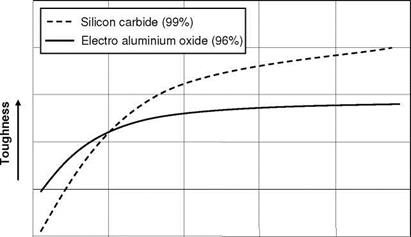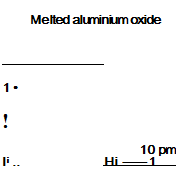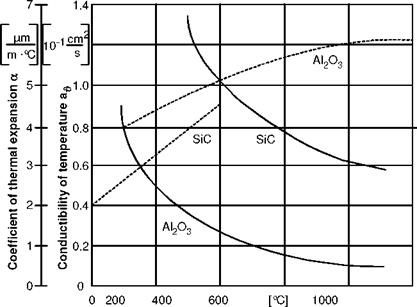A high degree of hardness and toughness and high amounts of stability and thermal conductivity are the primary requirements placed on an abrasive grit. These properties are influenced by chemical composition, crystal structure as well as by the grit size. In table 3-2, the main components of various types of corundum and their most important properties are shown. For comparative purposes, the grit materials silicon carbide, cBN and diamond are also displayed [COLL88, JUCH86, LEIC75, LUDE94, N. N.4, SCHE81, UHLM96]. Hardness and toughness are mostly dependent on the composition of the grit material. Pure white corundum has a Knoop hardness of 2160 HK. Brown and normal corundum exhibit, due to incomplete reduction, residual oxides, which exist mainly in the form of titanium oxide TiO2. Titanium oxide causes an increase in the lattice constants of electrocorundum, from which results a decreased hardness of this grit type [COES71].
On the other hand, contaminating oxides can improve the toughness of the grit material. This can be shown with the help of a bray machine, in which a certain amount of abrasive grits are subjected to shear and impact stress. Fig. 3-4 shows the percentile amount of grits that remained undamaged after the pulverising experiment. According to it, the toughness of electro-corundum clearly decreases with increasing purity. This amounts to a toughness increase from white to brown to normal corundum. In order to improve the toughness of white fused corundum, small amounts of Cr2O3 are added during the production process. These cause a toughness increase at the same hardness, e. g. in pink and red corundum [BRAD67].
|
Table 3-2. Application areas of synthetic grit materials
|
|
Table 3-2. Application areas of synthetic grit materials (continued)
|
|
Table 3-3. Composition and properties of synthetic grit materials
|
![Подпись: Fig. 3-4. Higher purity in the grit material lessens its toughness [BRAD67]](/img/3149/image022_4.gif)
Compared to white fused corundum, mono-crystalline corundum exhibits a higher level of toughness at scarcely lower hardness. This is based on the facts that, as opposed to white and normal corundum, the grit boundaries of monocrystalline corundum are formed by crystal layers, and that the toughness properties of mono-crystalline corundum are clearly improved due to the lack of lattice defects.
By adding zircon dioxide (ZrO2) in the manufacturing process of corundum, so-called zircon corundum can be produced. An addition of 25 % to 40 % of zircon dioxide causes a noticeable increase in grit toughness. The principal mechanism of this increase in toughness is based upon the temperature-dependent crystal structure of zircon dioxide, which is associated with a change in volume. Thus, with a suitable regulation of temperature during cooling, compressive residual stresses can be induced in the grit. These compressive residual stresses work against the growth of cracks, thereby improving the toughness of the grit. The hardness of the zircon corundum, on the other hand, is significantly lower than that of fused corundum [LUDE94].
The influence of the grit size on grit toughness for both normal corundum and silicon corundum is represented in Fig. 3-5. Toughness proves to diminish with increasing grit size, while it increases when the grit structure is finer. Thus, corundum manufactured by means of the billet method (crystal diameter up to 1200 pm) are more brittle than those produced with the tapping method (crystal diameter of abut 400 pm) [COES71, PEKL60].
A reduction in crystal size amounting to about 25 pm can be achieved with sintered bauxite corundum. The fine crystalline structure of this corundum type is responsible for its high level of toughness.
|
|
|
8 |
50 |
100 150 Grain size |
200 |
240 |
|
2600 |
324 |
l37 97 Grit diameter |
[Mm] |
49 |
|
Fig. 3-5. Toughness of Al2O3 and SiC as a function of the grit size |
Microcrystalline structures that further enhance toughness can be found in sol — gel corundum. The latter have crystal sizes under 500 nm. It is assumed that crack proliferation can be reduced or hindered by reducing the crystal size [BRUN97, LUDE94]. Especially micro-crack formation, which occurs as a result of dislocation yield stress at the grit boundaries, can take on properties that increase toughness [ENGE02].
The microcrystalline structure of sol-gel corundum results in a more favourable fracture behaviour for the grinding process compared with conventionally fused corundum [BRUN97, MUEL02]. Fused corundum has fracture planes, at which relatively large particles break out in clods under strain (Fig. 3-6). Due to their microcrystalline structure, sol-gel corundum lacks these slip planes. As a result, only relatively small particles chip off and the grit maintains it sharpness [COLL80].
The most crucial thermal properties of a grit material are its temperature conductivity, pressure softening point and melting point. Temperature conductivity is a measure of a material’s capability to balance out differences in temperature, i. e. to transfer temperature. If it is assumed that an individual grit is strained with a punctiform heat source due to chip formation at its cutting edge, if the temperature
conductivity is good, the added heat is distributed quickly across the grit. Thus, the applied increase in temperature reaches equilibrium rapidly.
Fig. 3-6. Comparison of the microstructure and fracture properties of fused corundum and sol-gel corundum
Fig. 3-7 shows that the temperature conductivity of Al2O3 reduces significantly with increasing temperature. Therefore, at high temperatures, one can expect that the heat stress will concentrate increasingly on the cutting edge and that extreme temperature peaks will occur here. Since, with increasing temperature, the thermal coefficient of expansion also goes up, temperature differences lead additionally to increasingly large thermal stresses in the grit. These thermally dependent stresses can also appear between the grit and the bond if the grit’s and the bond’s thermal coefficients of expansion deviate from each other excessively. Aluminium oxide has a pressure softening point of 1750 °C and its melting point is 2050 °C [COES71].
It has been proved in friction experiments that, under a large amount of pressure and temperature, spinels — especially iron spinel FeAl2O4 — are formed [KIRK74]. Tribochemical layers on the abrasive grits of sol-gel corundums were first demonstrated by Engelhorn [ENGE02].
These are composed of oxides and mixed oxides. Especially manganese, chrome and silicon were verified in comparatively high concentrations in the developed layers.
|
а
Temperature ft Fig. 3-7. Thermal properties of the abrasives Al2O3 and SiC [COES71] |
Uses
The uses of various abrasive grit materials, based on specifications provided by a range of abrasive grit manufacturers, are shown in table 3-2. The specific properties of the various grits and tool properties lead by necessity to special uses. Depending on the case, uses that do not appear in the table could also prove to be practicable, since the choice of an optimal abrasive grit is always contingent upon particular processing conditions. Hardened steels of up to 63 HRC, carbides and casting materials, even wood and plastic — all are processed with corundum, either bonded in grinding wheels or on abrasive belts.
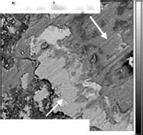 Material:
Material:
![]()

![]()
 100Cr6V, 61 ±1 HRC
100Cr6V, 61 ±1 HRC
Abrasive material:
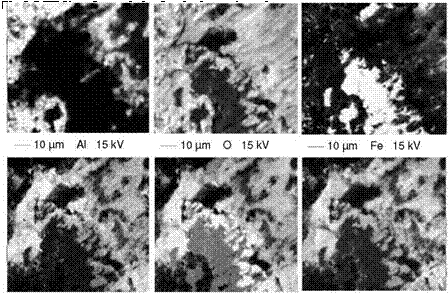 |
Sintered aluminium oxide

